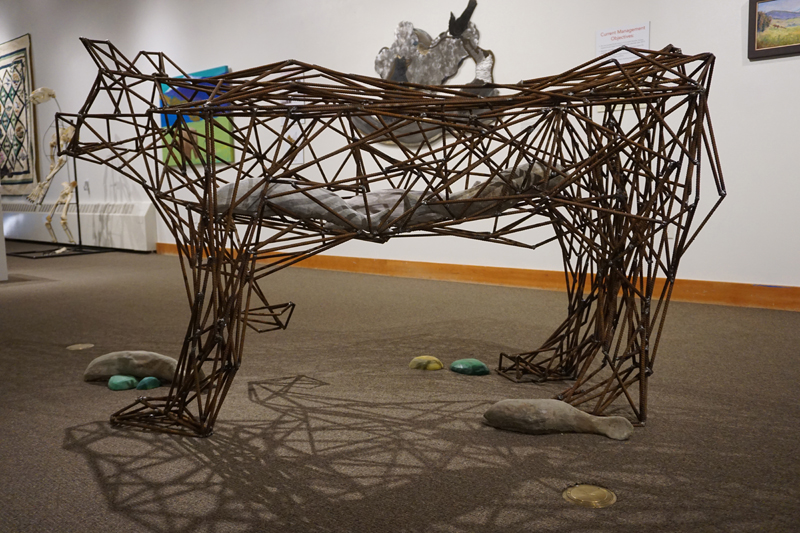Birch trees, bugs and now bears. For more than a decade, the Pratt Museum has brought together scientists and artists to explore aspects of natural history, culture and science. Partnering with organizations like the Kachemak Bay Research Reserve, the museum sponsors scientific talks and invites artists to learn about specific themes. Artists even do some hands-on science in Discovery Labs at the Alaska Islands and Ocean Visitor Center.
In the latest collaboration, “Art and Science of Bears,” showing through July 31, 11 artists look at bears in a variety of media and approaches. Photographer Mi’chelle Barnes takes a realistic approach with three images while artist Jo Going comes at the subject with her abstract painting, “Cosmic Bear.” Scott Bartlett, the museum’s curator of exhibits and the coordinator of the show, said some artists looked at the general idea of bears while others responded specifically to certain talks.
“Like a lot of things we do, these two different modes of looking at something are equally valid,” he said of the artistic and scientific approaches. “They don’t need to be explicitly tied together.”
Bartlett cited Fairbanks artist Jennifer Moss’ “42 Bears,” a mixed-media painting, as one work that bounced off a lecture. In October, John Morton of the Kenai National Wildlife Refuge presented “How Many Brown Bears are on the Kenai Peninsula?” The answer of 42 bears per 1,000 square kilometers, or 390 square miles, provides the title of Moss’ work.
Using a topographical map of the Kenai refuge as her canvas, Moss painted 42 bears of all ages and sizes, and of numerous poses, to give a sense of their density. Lines flowing through the illustration connect the bears.
“It’s more, not really the range in particular, but maybe that flow of movement and how they wander around,” Moss said.
The lines also can suggest water.
“Bears congregate around rivers and rely on rivers for their sustenance,” she said.
Going’s “Cosmic Bear” encircles the image of a bear in swirling lines. The lines also flow from images of hearts, galaxies and stars within the bear. The painting includes a poem Going wrote.
“The way I’ve created Bear, he/she is an archetype of bear that in turn will produce the bear that you will see in your home — well, hopefully, out of your window,” she said.
Hung on the back wall above the stairway in the museum’s main exhibit hall, “Cosmic Bear” “kind of looks over the whole thing,” Bartlett said. On the other side of the wall a video shows images of bears in the wild. Going said that’s a “perfect pairing.”
“It completes ‘Cosmic Bear’ to have the real bears right there beside it,” she said. “I feel like it’s the guardian of the whole exhibit.”
Most of the artists are from Homer or the lower Kenai Peninsula, but the statewide call for art also attracted artists from Anchorage and Fairbanks. Another Fairbanks artist, Tammy Holland, drove her life-size welded-rebar sculpture, “Bearily Summer,” just for the show. The work is like a cubist rendering of a bear, with hard edges. In a bit of playfulness, Holland also has added sculptures of salmon to the bear, some of them in its belly.
“It reminded me of a vector drawing in 3-D,” Bartlett said of Holland’s work.
“Bearily Summer” has a narrative feel — bear stalks fish, bear eats fish — that also is seen in Homer artist Richard L. Gustafson’s “Bear Memory from the End of East Skyline Drive.” That painting came about from a bear encounter Gustafson had in the 1990s when he saw a bear hunt a cow moose and her two calves.
“Every once in a while I saw the large dark head of the pursuing animal popping through the grass and fireweed, chasing the moose family,” Gustafson writes in his description of his painting. “Finally the cow and one calf emerged from the trees.”
More pastoral narratives include Edward Whetstone Hutchinson’s “Brown Bear and Cub Grazing Sedge Grass” and sculptor Jeff Dean’s image of a black bear and raven, “The One That Got Away or With a Little Help From a Friend.”
Many of the works in the show are simple representations of bears, like Ranja Dean’s clay sculpture, “Standing Grizzly,” Janet Bacher’s quilt, “In the Wild,” Elise Rose’s quilt, “Kenai Bear,” and Pamela Fraley’s watercolor, “Morning Steps.”
Going praised Fraley’s work.
“It was so sweet and so authentic. There was such a lovely feeling about it,” Going said. “You can tell this artist applies her brushstrokes with utmost love and attention.”
At the same time, the way Fraley paints the fur and shadows on the bear gives it a pointillist effect.
“You can zero in on it and get a square and you’ve got a beautiful abstract pattern,” Going said.
Bartlett said he was pleased by the variety of art received. Like other art-science collaborations, this show had an open call to artists, meaning any artist could enter. The exhibit also includes scientific exhibits like a bear skeleton and posters on aspects of bear biology.
“It was a good, diverse collection of art. It wasn’t too crowded. It wasn’t fighting each other,” Bartlett said. “It worked out well to have that science interspersing.”
The collaboration included a talk last night by naturalist guide Simyra Taback, “A Walk in the Park: Observing bears, wolves and other woodland creatures in Katmai.” At 6 p.m. June 22 is a talk by wildlife biologist Tom Smith of Brigham Young University, “Bear Safety Messaging: the Good, the Bad and the Ugly.”
Michael Armstrong can be reached at michael.armstrong@homernews.com.
Art and Science of Bears
On exhibit through July 31
wHEN:
10 a.m.–6 p.m. seven days a week
where:
Pratt Museum
Bear science talk
“Bear Safety Messaging: The Good, the Bad and the Ugly,”
by wildlife biologist Tom Smith
wHEN:
June 22, 6 p.m.
where:
Pratt Museum


